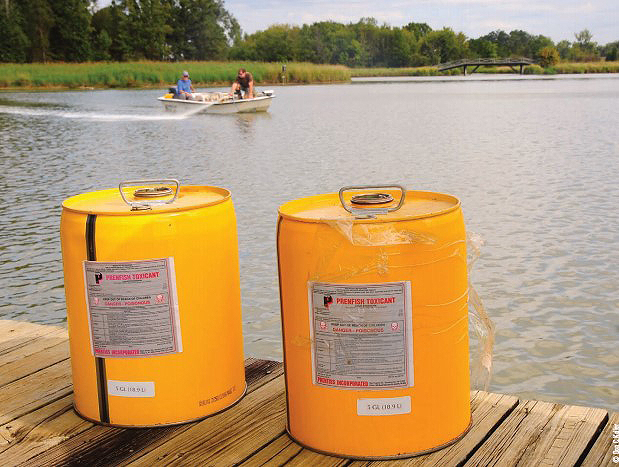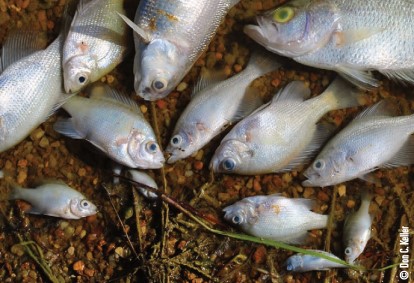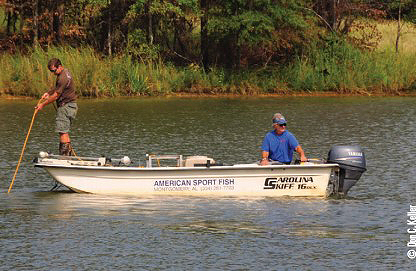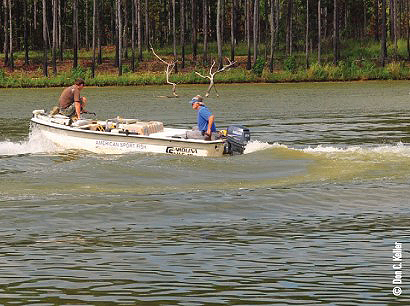Don C. Keller | Originally published in GameKeepers: Farming for Wildlife Magazine. To subscribe, click here.

There are more than 2.5 million ponds scattered across the United States. Most of these ponds provide fair to excellent recreational fishing opportunities. However, a variety of problems can affect pond fisheries as they age. Some of these problems are population imbalances due to poor management, the introduction of nuisance or unwanted species, and siltation or other loss of habitat. Most problems can be addressed and remedied by utilizing traditional management practices such as harvest strategies or corrective restocking.

of small crappie and gizzard shad. Starting over was the most
effective solution to this problem.
Occasionally, problems become so severe that renovation of the pond is warranted. One of the benefits of managing ponds as compared to large lakes, rivers or reservoirs is that when pond fisheries decline in quality, we have the option to simply start over. Pond renovation can be complete where all the fish are eradicated by draining the pond or by eliminating the fish with the use of rotenone. Rotenone is an EPA approved fish toxicant.
A pond does not have to be invaded by a nuisance species to be considered a candidate for renovation. It is often quicker and less expensive to renovate a fishery that is severely out of balance than to rely on traditional measures such as harvest and supplemental stocking of forage. Once a largemouth bass population becomes severely stunted, there is a good chance that the stunted fish will never reach their full potential. This is often the case in old ponds that have been neglected for years. In such cases, even the best management practices will not improve such a fishery to the level that can be created over the same period of time in a newly renovated pond.

dispersal of rotenone into the deeper water of the lake, thus
insuring a complete kill.
Arguably, some of the best fishing a pond can offer is in the first five to seven years after being stocked. Most pond fisheries decline after that period unless they are actively managed. Completely draining or poisoning a pond is certainly a drastic measure, but a complete renovation is often the quickest and most economical route to a better fishery. Anglers can begin harvesting sport fish one year after the bass fingerlings are stocked following a renovation project.
If the pond is to be drained then it is best to drain it in late summer so the bottom can be allowed to dry. Heavy equipment can then be utilized in the early fall to remove silt or create structure or add boat ramps.
For the past several years, many areas have experienced drought conditions and landowners have been very hesitant to drain ponds for fear that they won’t receive enough rainfall to refill the pond. In this case the lake can be treated full or partially full with rotenone to eradicate all of the existing fish.
Rotenone is a naturally occurring botanical substance found in the roots of certain tropical beans. Rotenone is registered as a restricted use pesticide by the EPA and the user must have a restricted use pesticide license to purchase the material.
A common misconception about the mode of action of rotenone is that it blocks the uptake of oxygen by restricting the blood flow in the gills. Actually rotenone is rapidly absorbed across the gill membrane and blocks oxygen uptake at the cellular level.
Rotenone is toxic primarily to fish and invertebrates. It is very low in toxicity to mammals, turtles and snakes. Rotenone comes as a liquid 5% material or as a wettable powder. The liquid is much more effective and easier to use. The amount of rotenone to use will be determined by water volume and the species of fish targeted. Bullhead catfish, gar, carp, goldfish and shiners require a higher rate than bass and sunfish and shad require even less. For ponds that have only bass and sunfish, one gallon for every two acre feet is sufficient. If the harder-to-kill species are present, then twice this rate is recommended.

the water using an outboard motor produces great results.
Rotenone is temperature sensitive. The warmer the water the quicker it kills and the quicker it biodegrades. In cold water, it works slower and persists longer. It is important to get the material dispersed throughout the water column. This can be done by using a sprayer or pump and holding the discharge end beneath the surface of the water. We then recommend you take a small outboard and stir the water vigorously to mix the rotenone from top to bottom. Fish will usually begin popping up to the surface in 30 to 45 minutes.
As a general rule, wait about two or three weeks before restocking. It is best to run a simple bioassay test before restocking. This can be done by getting a bucket of water from the pond and stopping by the bait store. Add about six to ten minnows to the bucket, and if they are alive the next morning, you should be good to stock.
The last question I usually get is “can we eat the fish that are killed by the rotenone?” Well, legally I have to say no because it is not on the label. No company is going to spend millions of dollars to add this to the label when it would not generate a profitable return. The natives in South America do eat the fish they kill with this plant material.
When I was a young biologist with the Alabama Game and Fish division, we would do population studies on all the major reservoirs using rotenone. We would block off a one to two acre cove and kill all the fish. We would then pick these fish up and sort by species and measure and weigh them. After we got our data recorded, we would pick out the bass, crappie and catfish and have a fish fry that evening. I was about 28 years old when these projects were done.
When this article goes to press, I will be 68 years old. I have noticed that when my wife is in the kitchen and I am in the next room, she has to repeat things two or three times. The third time is usually a scream. I have to wear glasses to watch television and different glasses to read. I am not as strong or fast as I used to be. I have a tendency to put on weight around my waist if I am not very careful. Now that I think about it, it may be all those rotenone-treated fish I ate.
Don Keller is a certified fisheries scientist and co-owner of American Sportfish.





























